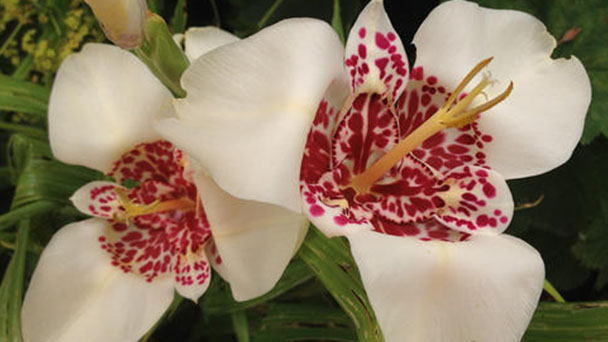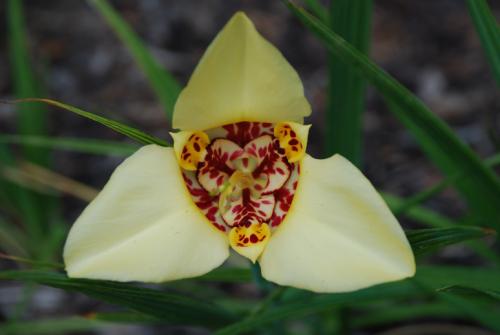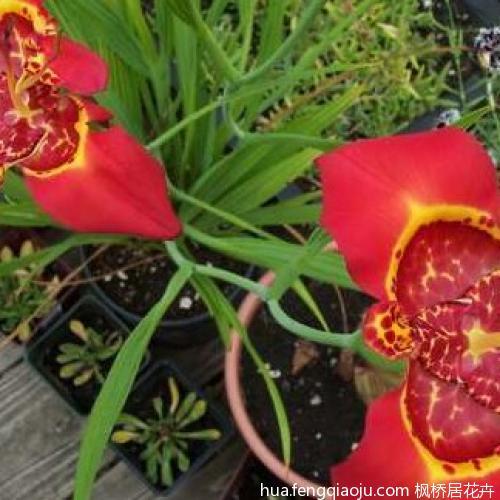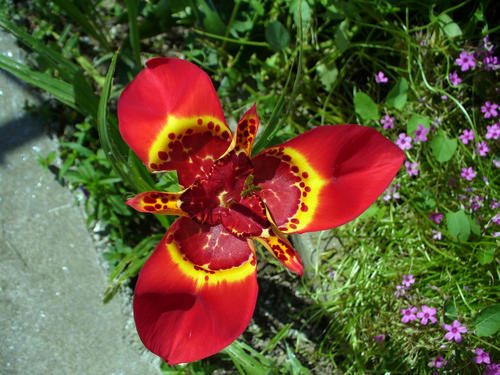Tiger Flower (Tigridia Pavonia) Profile
Written by Maggie
Oct 19 2021

Tiger flowers (Tigridia pavonia), also called jockey's cap lily, Mexican shellflower peacock flower, tiger iris, are bulbous flowers, 40 to 60 cm high. Blade is sword-shaped. Pedicels drawn from leaves, triangular abaxially, 6 petals, 3 large red, yellow, orange, pink, or white outer rings, 3 smaller inner rings with magenta, purple, or russet spots.
The Corm of Tiger flowers is ovoid, ca. 4 cm in diam., brown. Leaves are sword-shaped or broadly banding. Most of them are light purple, red, pink, yellow, white and other colors. In cold areas, the bulb should be dug out in autumn and put in a dry place indoors for the winter.
Tiger Flowers Picture

Tiger Flowers Info
| Botanical Name | Tigridia Pavonia |
| Common Names | jockey's cap lily, Mexican shellflower peacock flower, tiger iris, Tiger flowers |
| Plant Type | Bulb, corm |
| Sun | Full sun to part shade |
| Hardiness Zones | 8 - 10, USA |
| Flower color | Pink, red, yellow, white |
| Native Area | Mexico |
| Mature size | Up to 24 in. tall |
Tiger Flowers Characteristics
Tiger flowers are bulbous flowers, 40 to 60 cm high. Blade is sword-shaped. Pedicels are drawn from leaves, triangular abaxially, 6 petals, 3 large red, yellow, orange, pink, or white outer rings, 3 smaller inner rings with magenta, purple, or russet spots.
Tiger flowers are perennial herbs. Corm is ovoid, ca. 4 cm in diam., brown. Leaves are sword-shaped or broadly banate, 50-70 cm long, 1.5-1.7 cm wide, basally sheathlike, apically acuminate, slightly ruffled, with 4-6 main veins. Flower stems are erect, 70-120 cm tall, distally branched, peanut at apex of branching; Flowers are with 3-7 bracts, grassy, green, 7-12 cm long and 1.8 cm wide; Flowers are yellow, orange-red, or purple, with dark purple spots, 7 -- 12 cm in diameter; Pedicels of Tiger flowers are green, 6-9 cm long, perianth tubes semicircular, cup-shaped, outer perianth lobes elliptic or obovate, ca. 7 cm long and 3.5 -- 4 cm wide, apex spreading outward, inner perianth lobes obovate, smaller and narrower than outer perianth lobes, ca. 4 cm long and 1.5 cm wide; Stamens filaments connate with styles, ca. 6 cm long; Style is 3.8 -- 4 cm long, filiform, apically 6-lobed, ovary long cylindrical. Capsule is triangulated cylindrical, thick at the top and thin at the bottom, 6-7 cm long, about 1 cm in diameter, with permanent traces at the top.
Tiger Flowers Native Habits
Tiger flowers like warm, humid climates, ask for plenty of sunshine. Tiger flowers are suitable for growing on slightly acidic rich sandy loam soil.
Tiger Flowers Region
Tiger flowers are native to Guatemala and Mexico, widely cultivated throughout the world for ornamental. Varieties are very large, color changes are very big, mostly light purple, red, pink, yellow, white and other colors. In cold areas, the bulb should be dug out in autumn and put in a dry place indoors for the winter.
Tiger Flowers Care
Tiger Flowers Lighting Requirements
Tiger flowers are solar lovers, and you must function them so they get lots of it. Although they can tolerate some coloration in warm regions, they can also now not bloom as prolifically.
Tiger Flowers Soil Care
The perfect soil kind for your tiger plant life will be a specially well-drained one. A sandy or loamy range is perfect. Tiger flowers do not do properly in standing water.
Tiger Flowers Watering
While tiger plant life is established, you will favor preserving the soil constantly moist. Once mature, they shall nonetheless recognize ordinary watering, however they're tremendously drought-tolerant plant life and can cope with drier conditions.
Tiger Flowers Temperature & Humidity Care
If you prefer to experience your tiger flora for many seasons to come, Tiger flowers are fine grown in hotter regions. They do not cope with freezing temperatures and can cope with extreme heat.
If you're awaiting frosts, they're higher grown in containers. This capacity you can go to a warmer, sheltered place over the winter.
Tiger Flowers Fertilizer
A diluted liquid fertilizer can be utilized on the run-up to your tiger plant life bloom time to motivate a resplendent display.
How to Grow Tiger Flowers from Seed
Tiger plant life is grown from the fleshy underground stems of the plant, which are referred to as corms, as an alternative than from seeds. They typically flower in their 2nd yr after planting.
When planting these out, make certain you dig them at least a few inches deep and hold them round 5 inches apart.
Because the corms do not cope with bloodless conditions, plant them out in late spring, and preserve the soil moist till they're well-established.

Tiger Flowers Toxicity
The corms from the tiger flower are safe to eat when cooked. Although no longer toxic, they can be an irritant in the mouth if fed on raw, regularly inflicting a burning sensation. So take care if you have a grasping canine that likes to dig up backyard bulbs.
Tiger Flowers Propagation
Tiger flowers can be propagated by dividing the bulb or sowing the seeds. Tiger flowers are mainly propagated by dividing the bulb and are carried out in the dormant period of autumn. Planted in late spring, covered with soil of 5 to 8 cm, excavated bulbs for storage when leaves are withered and yellow before frost. Planting greenhouse potted flowers in cold and hot areas in autumn. Cultivation should be applied to sufficient base fertilizer, growing period of alum fertilizer water 1 to 2 times a month.
Tiger Flowers Uses
Arrange flower bed, flower mirror or plant in lawn, green space, and Tiger flowers also can be potted ornamental.

Latest Updated
- Benefits of Bugleweed - 7 Science-backed Health Benefits
- Bugleweed Dangers & Side Effects - Is It Poisonous?
- How to Plant Evergreen Trees - What You Should Know
- When to Plant Evergreens - Grow Guide for Evergreen Trees
- 12 Wonderful Evergreen Shrubs for Your Garden
- 12 Popular Evergreen Plants with Pictures for Beginners
- When And How To Prune A Lilac Bush Like a Pro
- How to Grow & Care for Lilac Vine (Hardenbergia Violacea)
- Japanese Lilac Tree (Syringa Reticulata) Care & Propagation Guide
- Shumard Oak Pros and Cons - What to Know
Popular Articles
- Winter maintenance of Antirrhinum Majus
- How to Grow Terminalia Mantaly Tree
- How to Grow and Care for Crossostephium Chinense
- How to grow Antirrhinum Majus in spring
- Peristeria Elata (Dove Orchid) Profile: Info & Care Guide
- Underwatered Snake Plant (Sansevieria Trifasciata) - Signs And How To Fix
- How to Care for Brazilian Jasmine Plant (Mandevilla Sanderi)
- How to Grow & Care for Graptopetalum Purple Delight in Summer
- Rosa Chinensis (China Rose): Plant Growing & Care Tips
- How to Care for Baby Sun Rose (Aptenia Cordifolia)